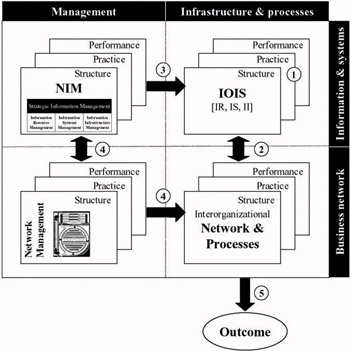Conclusions
|
| < Day Day Up > |
|
How can we explain the different outcomes of IOISs? In order to summarize our conceptually based answer, underscored with evidence from three cases, we will refer to the elements of the IOIS management framework (Figure 5) and their interrelations.

Figure 5: IOIS management framework
The network management framework has introduced different perspectives. Throughout this chapter, we argued from the firm’s perspective, primarily from a network initiator or operator’s perspective, which focuses on network issues.
-
Perspective on IOISs
IOISs can be characterized by their structural properties, i.e., information resources, systems and infrastructures, established practices and procedures for coordination, and collaboration and information exchange and their performances. Practices have to match the structural properties.
The three cases show the different outcomes or levels of success of IOISs: open in the TELCO case, initially negative in the DIMER case, and positive in the ONIA NET example. The underlying systems structure has been carefully planned in all cases, and the practices, e.g., for systems maintenance or security, do not provide evidence to explain the different outcomes.
-
IOISs and Networks
IOISs are facilitating network business models by extending the ranges of services and innovative value propositions and by network processes and practices, e.g., by improving the efficiency of distributed work. In return, network relations provide the strategic and organizational setting within which IOISs are run and which they are supposed to support.
While in the ONIA NET case the strategic rationale was supported by the participants and translated into the IOIS structure and practices, the contractors in the DIMER case did not buy into the new practices of collaboration.
-
Managing IOISs
IOISs are at the same time strategically promising and organizationally precarious arrangements that call for systematic and professional management, i.e., planning, organization, and control.
The domains of management tasks address the structural properties (and the related practices) of the IOIS. The value propositions of the three IOIS examples are based on improved availability and exchange of information throughout the network, which need to be supported by requisite systems and infrastructures. The three cases illustrate the interdependencies of managing information resources, systems, and infrastructures.
-
The network management framework
Even meticulous NIM alone cannot secure the outcome of IOISs. IOISs need to be strategically aligned with the purpose of the network and the strategic goals of its members. Furthermore, they need to be organization- ally embedded so that they can support network relations and processes.
The cases have highlighted the need to develop shared visions and incentives for the IOIS—successfully in the ONIA NET case, unsuccessfully in the DIMER example—and to build relationships and inter-organizational practices that provide initial support for the IOIS. Once in place, we observe a reciprocal relationship between the technically mediated and the social relationships: initial trust is essential for the setup of the IOIS, which then has to confirm and reinforce trust, e.g., through extended transparency among the network members.
-
Network processes lead to outcomes
Improved network (business) performance can hardly be directly linked to IOISs. The effects of IOISs are typically moderated by the network and processes.
The IOIS examples exhibit a high degree of versatility and a broad range of supporting or enabling properties. Again, it comes back to a management challenge to leverage the support potential into improved processes and outcomes and to do this in an efficient manner.
|
| < Day Day Up > |
|
EAN: 2147483647
Pages: 148